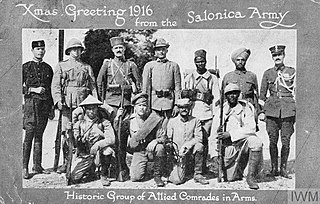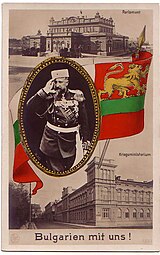The 53rd Infantry Division was a French Army formation during World War I and World War II.

Maurice Paul Emmanuel Sarrail was a French general of the First World War. Sarrail's openly socialist political connections made him a rarity amongst the Catholics, conservatives and monarchists who dominated the French Army officer corps under the Third Republic before the war, and were the main reason why he was appointed to command at Salonika.

The Macedonian front, also known as the Salonica front, was a military theatre of World War I formed as a result of an attempt by the Allied Powers to aid Serbia, in the autumn of 1915, against the combined attack of Germany, Austria-Hungary and Bulgaria. The expedition came too late and with insufficient force to prevent the fall of Serbia and was complicated by the internal political crisis in Greece. Eventually, a stable front was established, running from the Albanian Adriatic coast to the Struma River, pitting a multinational Allied force against the Bulgarian army, which was at various times bolstered with smaller units from the other Central Powers. The Macedonian front remained stable, despite local actions, until the Allied offensive in September 1918 resulted in Bulgaria capitulating and the liberation of Serbia.
The Tenth Army was a Field army of the French Army during World War I and World War II.
The Armée d'Orient (AO) was a field army of the French Army during World War I who fought on the Macedonian front.

During World War I, France was one of the Triple Entente powers allied against the Central Powers. Although fighting occurred worldwide, the bulk of the French Army's operations occurred in Belgium, Luxembourg, France and Alsace-Lorraine along what came to be known as the Western Front, which consisted mainly of trench warfare. Specific operational, tactical, and strategic decisions by the high command on both sides of the conflict led to shifts in organizational capacity, as the French Army tried to respond to day-to-day fighting and long-term strategic and operational agendas. In particular, many problems caused the French high command to re-evaluate standard procedures, revise its command structures, re-equip the army, and to develop different tactical approaches.

The Battle of the Crna bend was a two-month-long battle between the Bulgarian and the Entente armies. The battle took place in the Macedonian front during the First World War Allied Monastir Offensive in October and November 1916. After extremely heavy fighting and severe casualties on both sides, the Bulgarians retreated from Bitola on 19 November, taking positions at 5 km to the north by defeating all later attacks from there. However, the Entente entry in Bitola had no strategic value.

The Monastir offensive was an Allied military operation against the forces of the Central Powers during World War I, intended to break the deadlock on the Macedonian front by forcing the capitulation of Bulgaria and relieving the pressure on Romania. The offensive took the shape of a large battle and lasted for three months and ended with the capture of the town of Monastir. On an average depth of 50km, the Bulgarian First Army gave battle on six occasions, being forced to retreat five times.

The Autonomous Province of Korçë, sometimes referred to as Republic of Korçë, was an autonomous legal entity established in 27/10 December 1916, by the local French forces after the city of Korçë fell under their control during World War I, and which lasted until 1920.
The Battle of the Crna Bend was a significant military engagement fought between the forces of the Central Powers and the Entente in May 1917. It was part of the Allied Spring Offensive of the same year that was designed to break the stalemate on the Macedonian Front. Despite the considerable numerical and material advantage of the attackers over the defenders, the Bulgarian and German defence of the positions in the loop of the river Crna remained a formidable obstacle, which the Allies were unable to defeat not only in 1917 but until the end of the war.

Georges de Bazelaire was a Major General in the French Army. During World War I, Bazelaire commanded the 135th Infantry Regiment, the 27th and 38th Infantry Divisions and the 7th Army Corps.

The Battle of Lerin or Battle of Florina or Chegan offensive was an offensive operation of the Bulgarian army fought between 17–28 August 1916, during the First World War, in which they conquered the city of Florina but failed to take Chegan.
The Moroccan Division or the 1st Moroccan Division of 1914, initially the Marching Division of Morocco was an infantry division of France's Army of Africa which participated in World War I.
The 302nd Division was an infantry division of the German Army. It was formed during World War I, as part of the 11th German-Bulgarian Army, combining members of both nationalities and saw service on the Macedonian front. During this time it fought major battles at Crna Bend and the Vardar Offensive. It was dissolved on 30 September 1918, in the aftermath of the capitulation of the 11th German-Bulgarian Army.
12th Infantry Division was an infantry division of the French Army which took part in the Napoleonic Wars, World War I and World War II. It fought at the Battle of the Nations in 1813. It was converted to a motorised infantry role at Mourmelon-le-Grand in 1939 a few days before the French declaration of war on Germany and renamed 12th Motorised Infantry Division
The 31st Army Corps was a corps of the French army, created at the start of the First World War. From the date of its creation until June 1916, the army corps occupied front sectors in Lorraine. In June, the 31st Army Corps fought on the left bank of the Meuse during the Battle of Verdun. Subsequently, it occupied a front line sector in the Argonne, before being transported to the Italian Front as a reinforcement after the Italian defeat at the Battle of Caporetto, alongside the 10th Army (France). In March 1918, the army corps was redeployed to France, to face the German offensives, it was situated on the Somme front until the end of the war.
156th Infantry Division was an infantry division of the French Army during the First World War. It was deployed overseas, seeing action during the Gallipoli campaign, and thereafter on the Salonika front, fighting alongside British troops in both theatres of war. It was sent to the Crimea in December 1918 as part of the Army of the Danube.
122nd Infantry Division was an infantry division of the French Army during the First World War. It was deployed overseas, seeing action on the Salonika front, fighting alongside British troops. It was sent to the Crimea in December 1918 as part of the Army of the Danube.
57th Infantry Division was an infantry division of the French Army during the First World War. It was deployed overseas, seeing action on the Salonika front, fighting alongside British troops. It was sent to the Crimea in December 1918 as part of the Army of the Danube.
17th Colonial Infantry Division was an infantry division of the French Army during the First World War. It was deployed overseas, seeing action during the Gallipoli campaign, and thereafter on the Salonika front, fighting alongside British troops in both theatres of war. It was sent to the Crimea in December 1918 as part of the Army of the Danube.











